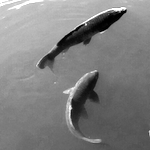The use of bioinspired soft actuators and soft robotics has increased in recent years. Compared to rigid mechanical designs, these approaches offer flexible engineering solutions that better approximate the movement of many biological structures. A ubiquitous flexible structure is the cilium, which plays an important role in a variety of functional and physiological processes involving locomotion, fluid/particle transport, and sensing. Cilia perform these functions across a range of length scales (from microns to millimeters), and are often metachronally coordinated (i.e., with phase lag between neighboring cilia). While low-Reynolds number ciliary hydrodynamics and coordination have long been a focus of study, these attributes are less well understood at intermediate Reynolds numbers. Ctenophores (comb jellies) have unusually large cilia (~1 mm in length), presenting a unique opportunity to study fluid structure interactions in flow regimes where both viscous and inertial forces are important (~1 < Re < ~100). Using a combination of emerging techniques, we designed a magnetically actuated row of propulsors inspired by the morphology and behavior of ctenophores' ciliary structures (ctene rows). These artificial ctene rows consist of magnetic microparticles suspended in a silicone elastomer, forming structures that can be actuated with an external magnetic field. An underlying timing belt translates permanent magnets, producing antiplectic metachronal motion (with a wave travelling the opposite of the beating direction). The speed and spacing of these translating magnets can be adjusted to encode different beat frequencies, wave speeds, and wavelengths. By adjusting these parameters, we explore the performance landscape of ctenophore-inspired fluid pumping with particle image velocimetry (PIV). Our results emphasize the efficiency and scalability of flexible biological structures, and offer insight into the design of aquatic robots and pumping/mixing devices.

 PDF version
PDF version
